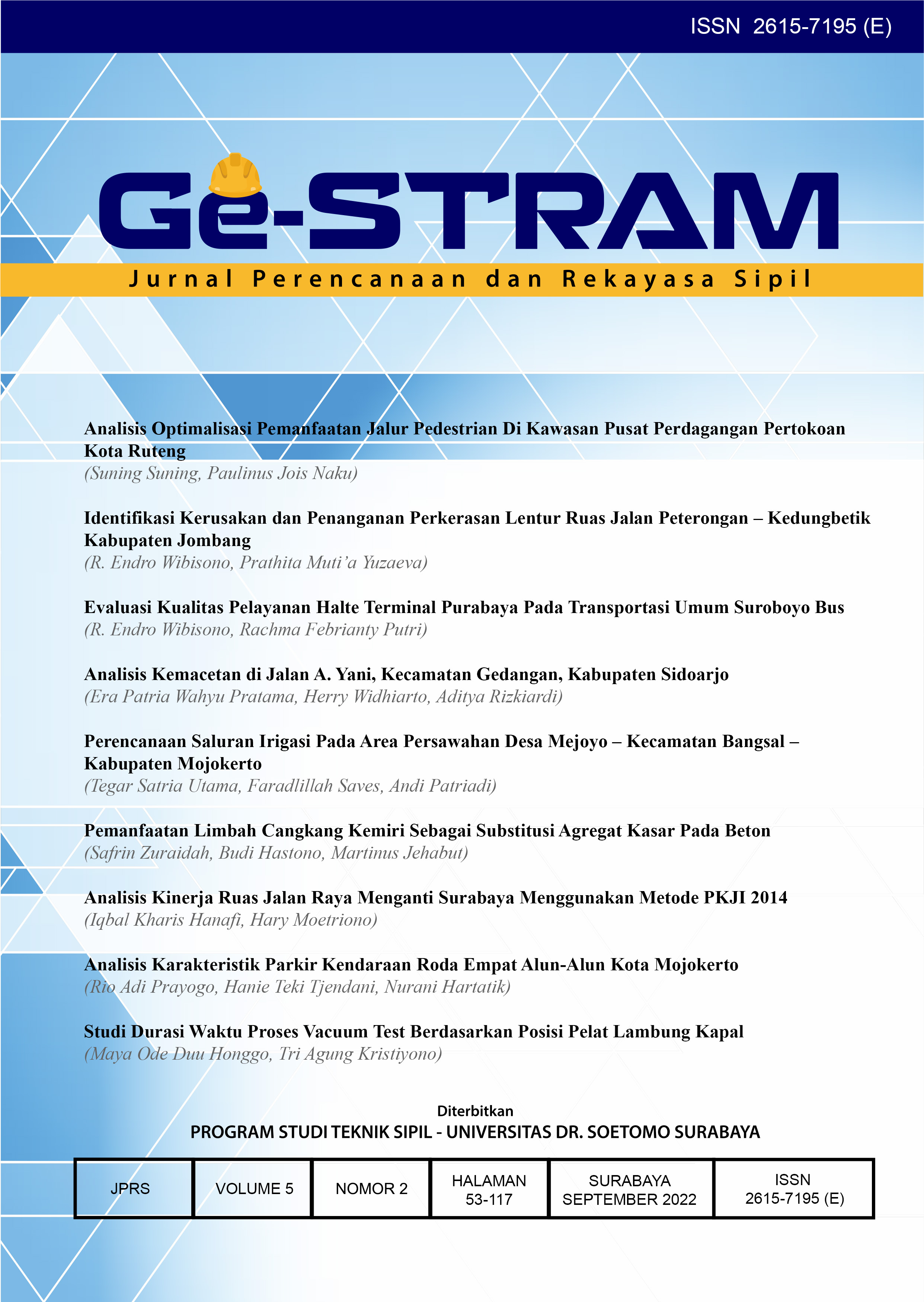Analisis Optimalisasi Pemanfaatan Jalur Pedestrian Di Kawasan Pusat Perdagangan Pertokoan Kota Ruteng
 Abstrak views: 358
,
Abstrak views: 358
,
 PDF (English) downloads: 515
PDF (English) downloads: 515
Abstrak
The pedestrian path in the shopping area of ​​Ruteng city is part of the road that functions as a separate circulation space for pedestrians for vehicle circulation, the separation is necessary for pedestrian safety. Optimizing the use of pedestrian paths in the shopping center area of ​​Ruteng City considers three main criteria, namely safety, comfort and convenience. The purpose of this study is to analyze the optimization of the use of pedestrian paths in the trade center area, Ruteng City shops. The research method used is descriptive qualitative-quantitative with Likert scale analysis techniques and AHP. Methods of collecting data were field observations, interviews, documentation studies and questionnaires. The results showed that optimizing the use of pedestrian paths in the shopping center area of ​​Ruteng City contained three criteria, namely security, comfort and convenience. The total value of optimizing the utilization of pedestrian paths is quite good with an average value of 58.95%. This is due to pedestrian capacity which is still relatively narrow, the existence of other user actors besides pedestrians who take advantage of the presence of pedestrians by occupying roads and pedestrian paths and the lack of availability of supporting facilities (street furniture). The policy direction shows that the main priority in optimizing the use of pedestrian paths in the shopping area of ​​Ruteng City is to increase the quality and capacity of the pedestrian dimension. The policy implication that can be done is that the government should immediately carry out pedestrian repairs in accordance with the standards and capacity of pedestrian dimensions in terms of safety, comfort and convenience.
Referensi
Badan Pusat Statistik. (2020). Kecamatan Langke Rembong Dalam Angka. Manggarai.
Ersina, S. (2017). Jalur Pedestrian Sebagai Salah Satu Fasilitas Perkotaan Di Jalan Prof. Abdurahman Basalamah, Makassar. National Academic Journal Of Architecture, 57-65.
Ginting, A. A. (2017). Pengaruh Jalur Pedestrian Terhadap Perilaku Pejalan Kaki Di Blok M Jakarta Berdasarkan Konektivitas Lokasi Transit. Surabaya: Institut Teknologi Sepuluh Nopember.
Indonesia, M. P. (2014). Pedomaan Perencanaan, Penyediaan, Dan Pemanfaatan Prasarana Dan Sarana Jaringan Pejalan Kakii Di Kawasan Perkotaan . Jakarta: Kementrian Pekerjaan Umum Republik Indonesia.
Prasetyo, H. E. (2014). Optimalisasi Penataan Fasilitas Pejalan Kaki Dengan Efisiensi Pergerakan Berdasarkan Pada Karakteristik Pedestrian . Teknik Sipil & Perencanaan, 29-38.
Pupr, S. M. (2018). Pedoman Perencanaan Teknis Fasilitas Pejalan Kaki. Jakarta: Kementrian Pekerjaan Umum Dan Perumahan Rakyat
Kementrian Pekerjaan Umum dan Perumahan Rakyat. (2017). Pedoman Bahan Konstruksi Bangunan dan Rekayasa Sipil: Perencanaan Teknis Fasilitas Pejalan Kaki. SE Menteri PUPR, 5–6. https://simantu.pu.go.id/personal/imgpost/197812092006042004/post/20190313135241__F__Pedoman_Fasilitas__Pejalan_Kaki.pdf
Peraturan Menteri Pekerjaan Umum Nomor : 03/PRT/M/2014. (2014). Pedoman Perencanaan, Penyediaan, dan Pemanfaatan Prasarana dan Sarana Jaringan Pejalan Kaki di Kawasan Perkotaan. Menteri Pekerjaan Umum Republik Indonesia, 2013, 8. http://pug-pupr.pu.go.id/_uploads/Produk_Pengaturan/Permen PUPR No 03-2014.pdf
Rahmat, S. Z. T., Planologi, J. T., Unggul, U. E., Arjuna, J., Tol, U., & Kebun, T. (2016). Arahan Penataan Jalur Pejalan Kaki Di Kawasan Pusat Kota Ruteng Berdasarkan Kriteria Keamanan. Jurnal Planesa, 7.
Sherly, N. S. N., (2015). Studi Optimalisasi Perparkiran dan Pedestrian di Fakultas Teknik Jurusan Sipil Universitas Lampung. JRSDD
Yunianto, Rahadi. (2018). Identifikasi Pedestrian Jalan Raya Pajajaran
Kota bogor. Jurnal Imiah Plano
##submission.copyrightStatement##
##submission.license.cc.by-sa4.footer##Authors who publish with this journal agree to the following terms:
- Authors retain copyright and grant the journal right of first publication with the work simultaneously licensed under a Creative Commons Attribution-ShareAlike 4.0 International License that allows others to share the work with an acknowledgement of the work's authorship and initial publication in this journal.
- Authors are able to enter into separate, additional contractual arrangements for the non-exclusive distribution of the journal's published version of the work (e.g., post it to an institutional repository or publish it in a book), with an acknowledgement of its initial publication in this journal.
- Authors are permitted and encouraged to post their work online (e.g., in institutional repositories or on their website) prior to and during the submission process, as it can lead to productive exchanges, as well as earlier and greater citation of published work (See The Effect of Open Access).

This work is licensed under a Creative Commons Attribution-ShareAlike 4.0 International License.















